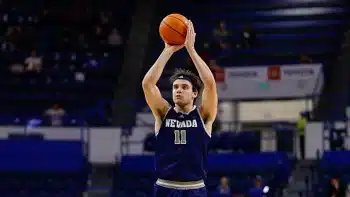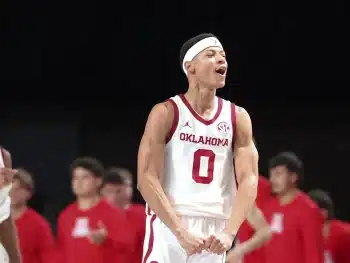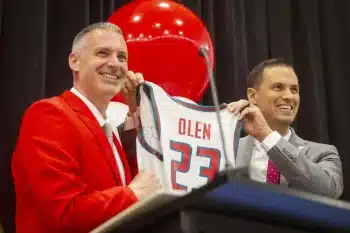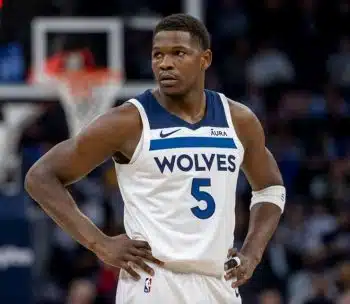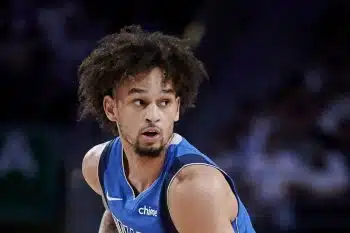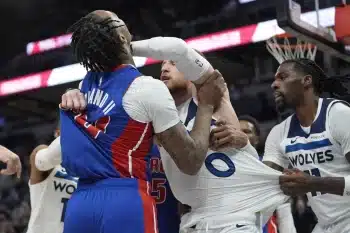NBA
Collins, Whiteside Appear Mismatched During Blazers’ Preseason Opener
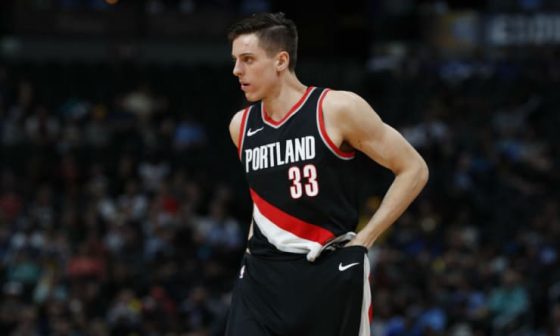
It’s been proven time and again that deducing meaningful conclusions from preseason basketball is mere folly. The games are often played at barely-more-than-half-speed, while teams don’t go through extensive scouting reports or implement major schematic changes related to specific opponents. Exhibition contests are far more about players and teams simply getting their feet wet against real competition leading up to the regular season grind than anything else.
But during the Portland Trail Blazers’ preseason opener at Veterans Memorial Coliseum — where, of note, the franchise won its only championship in 1977 — it was difficult not to wonder if the hopes of bringing another title to Rose City might be mitigated by a starting frontcourt that seems mismatched.
Zach Collins and Hassan Whiteside were on the floor for tipoff against the Denver Nuggets on Tuesday, as the Blazers have planned since late July. They played just about the opening seven minutes of the first quarter and headed to the bench with Portland trailing Denver 13-11. Both Whiteside and Collins returned to action in the second quarter, but not together. Whiteside was paired with Anthony Tolliver upfront, while Collins played center in a downsized lineup that slotted Rodney Hood at the de facto power forward slot.
That first quarter stint, it turned out, would be the lone occasion Collins and Whiteside were on the floor at once.
Head coach Terry Stotts downplayed the significance of that development after the game, alluding to a minutes restriction on Whiteside and the whims of exhibition play as the reason why the Blazers’ new starting bigs saw such brief court time simultaneously.
“That was because of minutes, Hassan was limited to 12 minutes,” he told Basketball Insiders. “It was predetermined he was gonna play the first six minutes with the one group, and then the next six minutes with the second. I think during preseason you’re gonna see different matchups at the 4-5.”
Whiteside missed multiple practices last week after tweaking his left ankle, plus Portland did indeed experiment with several different combinations in the post. Stotts specifically mentioned a desire to get the tandem of Collins and Skal Labissiere some run, which he did in the third quarter, and the Blazers slid Mario Hezonja down to power forward later on as both teams went deep into their bench units.
The limits of analyzing preseason basketball don’t need further explanation. But just because there’s only so much new to be learned from it hardly means exhibition play isn’t useful for confirming offseason talking points.
For Portland, that came in the form of a newfound emphasis on pace propelled by the addition of multiple capable ball handlers. Bazemore, ultra-disruptive in his Blazers debut with a whopping seven steals, routinely pushed the ball up the floor himself — even when playing with Damian Lillard and C.J. McCollum. Hezonja lived up to his teammates’ training-camp hype by mostly functioning as a true point forward. During his biggest and most exciting moment on the open floor, Hezonja went coast-to-coast off a defensive rebound before dumping the ball behind his head to Whiteside for a layup.
Lillard, McCollum, Anfernee Simons and even Bazemore all dribbled into pull-up jumpers after bringing the ball up the court without making a single pass.
The result was a blistering first-half pace of 112.0, nearly eight possessions more than the Atlanta Hawks’ league-leading average last season. That number suggests the Blazers were able to play fast, even with Collins and Whiteside on the floor. But a deeper dive into the advanced box score reveals that breakneck pace was owed almost solely to their second unit – especially notable given the struggles of the starters in the halfcourt.
Ignore the poor shooting for now as Portland may not play a half all season in which Lillard and McCollum combined to go 5-of-15 overall and 1-of-8 from beyond the arc. The Blazers don’t need to worry about their star backcourt misfiring on a few makable jumpers. Nonetheless, Lillard and McCollum could find it tough to find room to operate in the halfcourt when playing with Collins and Whiteside.
Like Al-Farouq Aminu in years past, defenses just won’t feel the need to guard Collins away from the ball when he’s spotted up from deep until he proves he’s a reliable three-point shooter. Making matters worse is the difficulty Whiteside has operating in a crowd, cue the video evidence:
Collins isn’t on the floor in the second clip, but Portland’s mucked-up spacing, with Hood in the dunker spot and the strong-side corner empty, make it a facsimile of what the Blazers can count on seeing this season while Collins and Whiteside are playing together. Neither is a good screener, either, with Collins hindered by his lack of girth and Whiteside’s longtime indifference to the finer points of basketball – which contributed to his demise as a building block for the Miami Heat – almost fully ingrained.
Those worries will be at least partially alleviated if Collins improves as a shooter. He sarcastically joked that he didn’t shoot any threes this summer at media day before describing all the work he put in and looked confident from range against Denver despite missing both of his attempts.
Collins’ three made jump shots from the right elbow area, meanwhile, serve as both an encouraging example of his natural perimeter touch and the spacing and efficiency pitfalls of playing him at power forward if he remains most comfortable from mid-range.
Reminder: It is far, far too early to write off the long-term viability of Collins and Whiteside as Portland’s starters in the frontcourt.
In any case, the Blazers are bound to get more comfortable offensively with them on the floor together given additional playing reps. Collins has never started at power forward before and Whiteside, as he loves to remind reporters, has never played in an offense that asks him to handle the ball on the perimeter.
But Portland certainly wouldn’t be the first team to stagger a pair of starters after the first and third quarters, and their new priority of increased pace clearly makes Hood, Hezonja or even Tolliver a better stylistic fit at power forward than Collins – before accounting for their superior ability to stretch the floor, too.
If the Trail Blazers want to remain true conference contenders, they’ll need to figure out their new on-court intricacies sooner rather than later — thankfully, the preseason is the perfect playground to do so.
